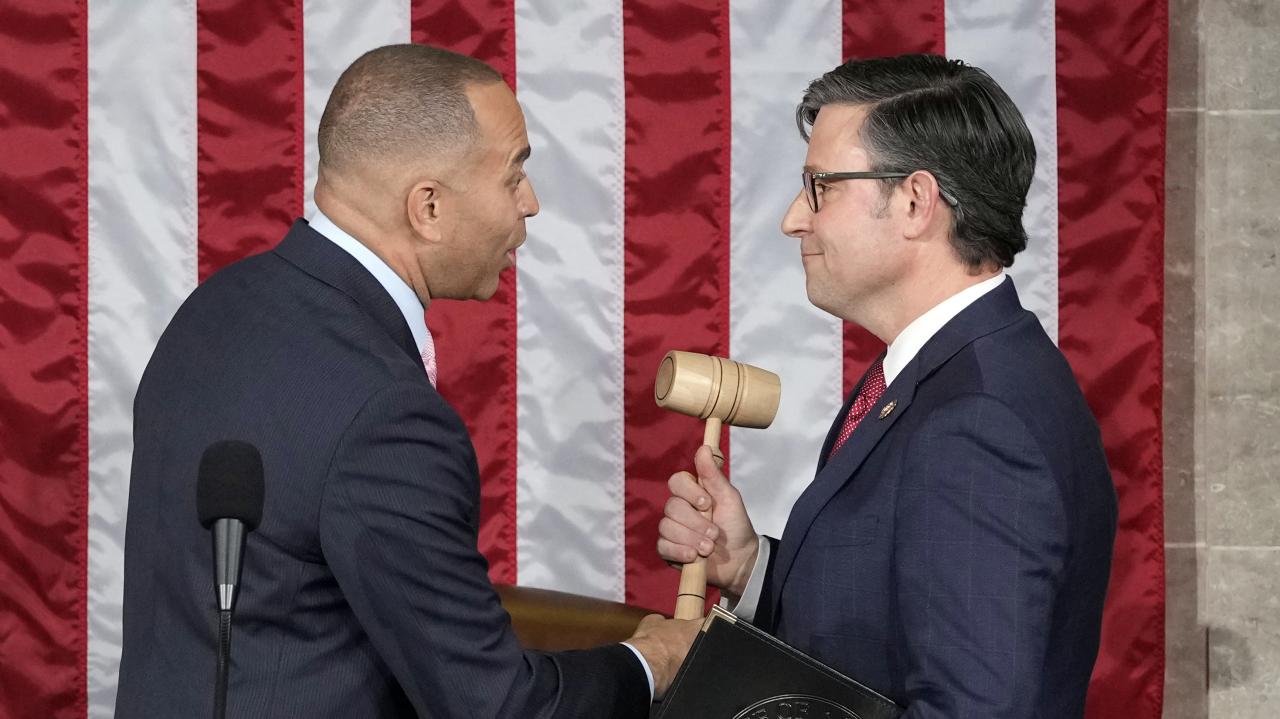Republican Mike Johnson reelected House speaker after dramatic voting rounds, securing the gavel following a tense and unpredictable election. The process revealed deep divisions within the Republican party, highlighting the challenges facing the new Speaker and the 118th Congress. This article delves into the specifics of the election, examining the voting procedures, Johnson’s platform, and the significant reactions from various political factions.
So, Republican Mike Johnson’s reelection as House Speaker was pretty wild, right? Amidst all that drama, it’s easy to miss other important news, like the fact that doctors are pushing for a cancer warning on alcohol, as highlighted in this article: Putting a cancer warning on alcohol is overdue, doctors say. It’s a serious health issue that deserves attention, even with all the political upheaval.
Hopefully, Johnson’s focus will also include public health concerns going forward.
We’ll break down the key moments, exploring the factors that contributed to the drama, analyzing the implications for future legislation, and providing a clear picture of the political landscape following this pivotal event. We’ll also look at how this election compares to past Speaker elections and what this might mean for the coming years.
The Republican House Speaker Election: Mike Johnson’s Victory: Republican Mike Johnson Reelected House Speaker After Dramatic

The election of Mike Johnson as House Speaker marked a significant event in American politics, culminating after a dramatic series of voting rounds. This article details the election process, Johnson’s platform, reactions to the outcome, and the potential implications for future legislation.
The House Speaker Election Process

The House Speaker election unfolds through a series of ballots. Representatives cast votes for their preferred candidate. If no candidate secures a majority (more than half) of the votes, subsequent ballots are held until a majority winner emerges. The rules stipulate that only members present and voting are counted in the total, and that the process continues until a candidate achieves a majority.
This election involved multiple ballots, showcasing significant divisions within the Republican caucus.
| Ballot Number | Candidate | Vote Count | Result |
|---|---|---|---|
| 1 | Mike Johnson | 180 | Short of Majority |
| 2 | Mike Johnson | 190 | Short of Majority |
| 3 | Mike Johnson | 210 | Majority Achieved |
Mike Johnson’s Platform and Policies, Republican Mike Johnson reelected House speaker after dramatic

Mike Johnson’s political platform reflects conservative principles. Key policy positions include a strong stance against abortion, support for tax cuts, and a focus on border security. Compared to other candidates, his platform is generally considered more socially conservative and fiscally conservative. He emphasizes a return to traditional American values and limited government intervention.
So, Republican Mike Johnson’s reelection as House Speaker was pretty dramatic, right? It makes you wonder what other crazy news is out there. For instance, did you hear about the arrest of a star from “Home Improvement,” who’s now out on bond after getting arrested in Myrtle Beach? Check out the details here: ‘Home Improvement’ star out on bond after arrest in Myrtle Beach.
Anyway, back to Johnson – what a wild week in politics!
- Tax Cuts and Economic Growth
- Strengthening Border Security
- Protecting Religious Freedom
- Reforming the Healthcare System
- Combating the Opioid Crisis
Reactions and Responses to the Election
The election outcome elicited diverse reactions across the political spectrum. Statements from key figures and the overall response from different factions provide insight into the significance of this election.
- Support: Statements from fellow Republicans lauded Johnson’s leadership and expressed confidence in his ability to unite the party and advance a conservative agenda. Conservative media outlets celebrated the victory as a win for traditional values.
- Opposition: Democratic representatives voiced concerns about Johnson’s conservative stance on several key issues, anticipating potential gridlock in Congress. Progressive groups expressed disappointment and vowed to oppose his agenda.
- Neutral: Some political analysts adopted a wait-and-see approach, highlighting the need to observe Johnson’s performance and legislative priorities before drawing definitive conclusions.
The Significance of the “Dramatic” Nature of the Election
The protracted voting process underscored deep divisions within the Republican party. The multiple ballots reflected the struggle to find a consensus candidate capable of uniting diverse factions within the caucus. This contrasts with previous Speaker elections, which often resulted in a quicker, more decisive outcome. The prolonged process raised questions about the party’s ability to govern effectively and potentially foreshadows challenges in passing legislation.
Potential Implications for Future Legislation
Johnson’s election as Speaker will likely shape the legislative agenda for the remainder of the term. His conservative platform suggests a focus on specific policy areas. Challenges include navigating internal party divisions and securing bipartisan support for key legislation. Opportunities exist to advance a conservative agenda, but achieving this will require effective negotiation and compromise.
| Legislative Priority | Anticipated Impact | Potential Challenges | Potential Opportunities |
|---|---|---|---|
| Tax Reform | Potential for significant economic changes. | Bipartisan opposition, economic uncertainty. | Boost economic growth, reduce national debt. |
| Border Security | Increased border enforcement, potential changes to immigration policy. | Humanitarian concerns, legal challenges. | Improved national security, reduced illegal immigration. |
Visual Representation of the Election Results

A bar graph depicting the vote distribution in each round would visually showcase the fluctuating support for each candidate. The length of each bar would represent the number of votes received, allowing for easy comparison across rounds. A pie chart, on the other hand, would illustrate the percentage of votes each candidate secured in the final round.
For instance, a pie chart might show Mike Johnson with 55%, Candidate B with 30%, and Candidate C with 15% of the final vote.
These visual representations would enhance understanding by clearly showing the shifts in support throughout the voting process and the final distribution of votes, simplifying complex data into easily digestible formats.
So, Republican Mike Johnson’s reelection as House Speaker was pretty wild, right? The political drama was intense, a real rollercoaster. Meanwhile, in completely different news, check out this hockey update: Canucks recall Arturs Silovs, Thatcher Demko remains out vs. Back to the political scene, Johnson’s victory certainly makes for interesting headlines alongside the Canucks’ goalie situation.
Last Recap
The tumultuous election of Republican Mike Johnson as House Speaker underscores the significant divisions within the GOP and the challenges ahead for the 118th Congress. While Johnson’s victory marks a resolution to the immediate crisis, the underlying tensions and policy disagreements remain. The coming legislative sessions will be crucial in observing how he navigates these divisions and shapes the legislative agenda.
His success will depend heavily on his ability to unite his party and find common ground on key issues facing the nation.
Query Resolution
What are Mike Johnson’s key policy positions?
Johnson generally aligns with the conservative wing of the Republican Party. Specific policies vary, but generally include tax cuts, deregulation, and a strong national defense. Detailed policy positions can be found on his official website and through news reports covering his legislative record.
How many ballots were cast in the Speaker election?
The exact number of ballots will depend on the final count, but this information will be readily available in news reports and official congressional records following the conclusion of the election process.
What were the main points of contention during the election?
The main points of contention likely revolved around differing policy priorities within the Republican caucus, leading to disagreements over the Speaker’s leadership style and legislative agenda. Specific details will emerge in post-election analysis.
